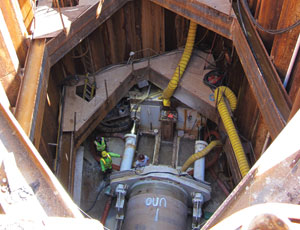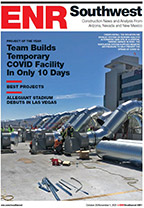For the first time in more than a half- century, crews on various projects are using a larger, stronger iteration of steel H-shaped piles recently approved by industry groups. The piles, typically used to construct deep foundations for buildings and bridges, also can save money on column applications, according to contractors and engineers.

For years, H-pile cross sections have measured as large as 14 in. The new piles, designated HP16 and HP18, “go up to 18-inch cross sections, so now you’ve got bigger loads you can carry,” says Charlie Carter, chief structural engineer for the American Institute of Steel Construction. “Now you can drive fewer piles [and reduce] stiffeners and doublers.”
The largest H-pile had been 117 lb per linear ft, says Mike Engestrom, technical marketing director with Nucor-Yamato Steel, Blytheville, Ark., the manufacturer. “We thought it would be nice if we could produce one or two additional depths of larger sections,” which the firm concluded would be possible considering the advancement of pile-driving systems.
Working with contractors, Nucor-Yamato drove test piles last year in sensitive soils, says Ashraf Elsayed, a principal with Hall, Blake & Associates, Memphis, Tenn. Unlike smaller sizes, he adds, the new sections can carry heavier loads while also meeting building codes that call for compact sections.
ASTM International (formerly American Society for Testing and Materials) accepted the new piles in its standard specifications, and AISC included them in its 2010 manual, says Carter. The piles are being used to help build a wind tower in New Jersey, levees in New Orleans and a sewer project in Hawaii.
The ASTM standard spec includes six HP16 piles, varying from 88 to 183 lb per ft, and four HP18 piles, varying from 135 to 204 lb per ft. Used as sheet pile shoring for a microtunnel on the sewer project in Hawaii, they could save almost $20,000 in materials and labor, says Tim Pearia, engineer with Frank Coluccio Construction, Seattle, which has the $37-million contract.
The quarter-mile sewer line will have a 72-in. diameter, twice the size of a typical project, Pearia says. Normally, wide-flange 14-in. sections with reinforcement would be needed. Thanks to the new HP16 piles, crews will need one or two fewer frames for each of the five shafts, reducing the total amount of material needed by about 500 ft. The contractor installed the first of 15 piles last fall.
“For years, that 14-inch H-pile section was the biggest thing you could get, so it’s nice to have another size,” according to Pearia. “The guys really like that heavier web. It’s just a sturdier cross section all around.”





Post a comment to this article
Report Abusive Comment